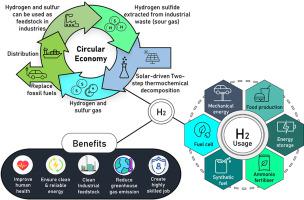当前位置:
X-MOL 学术
›
J. Clean. Prod.
›
论文详情
Our official English website, www.x-mol.net, welcomes your
feedback! (Note: you will need to create a separate account there.)
Gate-to-gate life cycle analysis of a pilot-scale solar driven two-step thermochemical hydrogen sulfide decomposition for hydrogen production
Journal of Cleaner Production ( IF 9.7 ) Pub Date : 2023-10-17 , DOI: 10.1016/j.jclepro.2023.139369
Kalppana Chelvam , Marlia M. Hanafiah , Khalid Al Ali , Asma Al Blooshi
Journal of Cleaner Production ( IF 9.7 ) Pub Date : 2023-10-17 , DOI: 10.1016/j.jclepro.2023.139369
Kalppana Chelvam , Marlia M. Hanafiah , Khalid Al Ali , Asma Al Blooshi

|
Hydrogen is one of the most viable options towards decarbonization. It is crucial to upscale the hydrogen economy considering the current state of the environment due to the adverse effects of climate change. In this study, a gate-to-gate Life cycle assessment (LCA) was conducted on a hydrogen sulfide splitting model that replicates a pilot-scale plant by integrating the two-step solar thermochemical HS decomposition using SimaPro version 9.4.0 software. This analysis starts from the treatment of HS gas released by the refineries as waste and ends at the production and storage stage of hydrogen. There are two functional units used in this study which are ‘1 kg of H’ to assess the operational phase of the simulation plant and ‘1 unit of HS splitting plant’ to determine the environmental performance of the construction of the plant. The top three most impacted midpoint level categories in the operational phase are human carcinogenic toxicity (HTP), freshwater ecotoxicity and marine ecotoxicity with an amount of 3.66 × 10, 1.10 × 10, and 1.40 × 10 kg 1,4-DCB respectively. Electricity has a higher relative contribution to this technology due to the high amount of steel used during the construction of solar tower. Meanwhile, treating HS leaves a positive impact towards every midpoint indicator, mainly on terrestrial acidification, fine particulate matter formation and ionizing radiation. The HS splitting technology was set as the baseline to compare with various other H production technologies. Scenario analysis was assessed by setting the solar-powered electricity as the baseline and was compared with electricity from different sources such as wind, nuclear and the United Arab Emirates (UAE) grid for the HS splitting plant. Moreover, uncertainty analysis using Monte Carlo simulation suggests that the probability of gaining results of HTP is the highest between 3.62 × 10 to 1.34 × 10 kg 1,4-DCB. It can be concluded that electricity powered by renewable sources significantly reduces the environmental burden from the scenario analysis conducted.
中文翻译:

中试规模太阳能驱动两步热化学硫化氢分解制氢的全生命周期分析
氢是脱碳最可行的选择之一。由于气候变化的不利影响,考虑到目前的环境状况,扩大氢经济至关重要。在本研究中,对硫化氢分解模型进行了门到门生命周期评估 (LCA),该模型通过使用 SimaPro 9.4.0 版软件集成两步太阳能热化学 H2S 分解来复制中试规模工厂。该分析从炼油厂排放的 H2S 气体作为废物的处理开始,到氢气的生产和储存阶段结束。本研究使用两个功能单元,即“1 kg H”,用于评估模拟工厂的运行阶段;“1 个单元的 H2S 分离工厂”,用于确定工厂建设的环境绩效。运行阶段受影响最大的三个中点水平类别是人类致癌毒性(HTP)、淡水生态毒性和海洋生态毒性,其量分别为3.66 × 10、1.10 × 10和1.40 × 10 kg 1,4-DCB。由于太阳能塔建设过程中使用了大量钢材,电力对该技术的相对贡献较高。同时,处理热射病对每一个中点指标都产生积极影响,主要是陆地酸化、细颗粒物形成和电离辐射。 H2S分解技术被设定为与其他各种H2生产技术进行比较的基准。通过将太阳能电力作为基线进行情景分析评估,并与来自风能、核能和阿拉伯联合酋长国 (UAE) 电网等不同来源的电力进行比较。此外,使用蒙特卡罗模拟的不确定性分析表明,获得 HTP 结果的概率在 3.62 × 10 到 1.34 × 10 kg 1,4-DCB 之间最高。从情景分析中可以得出结论,可再生能源发电显着减轻了环境负担。
更新日期:2023-10-17
中文翻译:

中试规模太阳能驱动两步热化学硫化氢分解制氢的全生命周期分析
氢是脱碳最可行的选择之一。由于气候变化的不利影响,考虑到目前的环境状况,扩大氢经济至关重要。在本研究中,对硫化氢分解模型进行了门到门生命周期评估 (LCA),该模型通过使用 SimaPro 9.4.0 版软件集成两步太阳能热化学 H2S 分解来复制中试规模工厂。该分析从炼油厂排放的 H2S 气体作为废物的处理开始,到氢气的生产和储存阶段结束。本研究使用两个功能单元,即“1 kg H”,用于评估模拟工厂的运行阶段;“1 个单元的 H2S 分离工厂”,用于确定工厂建设的环境绩效。运行阶段受影响最大的三个中点水平类别是人类致癌毒性(HTP)、淡水生态毒性和海洋生态毒性,其量分别为3.66 × 10、1.10 × 10和1.40 × 10 kg 1,4-DCB。由于太阳能塔建设过程中使用了大量钢材,电力对该技术的相对贡献较高。同时,处理热射病对每一个中点指标都产生积极影响,主要是陆地酸化、细颗粒物形成和电离辐射。 H2S分解技术被设定为与其他各种H2生产技术进行比较的基准。通过将太阳能电力作为基线进行情景分析评估,并与来自风能、核能和阿拉伯联合酋长国 (UAE) 电网等不同来源的电力进行比较。此外,使用蒙特卡罗模拟的不确定性分析表明,获得 HTP 结果的概率在 3.62 × 10 到 1.34 × 10 kg 1,4-DCB 之间最高。从情景分析中可以得出结论,可再生能源发电显着减轻了环境负担。































 京公网安备 11010802027423号
京公网安备 11010802027423号